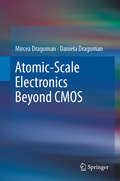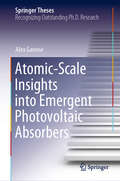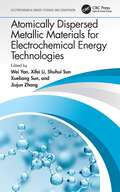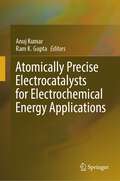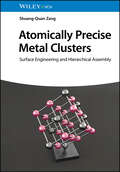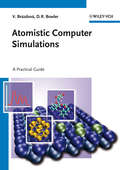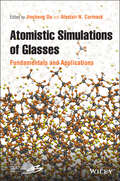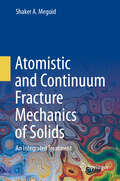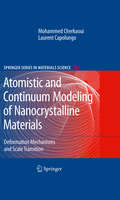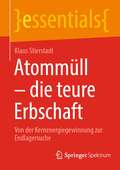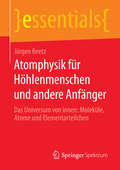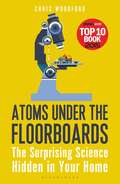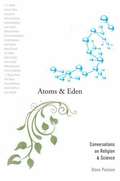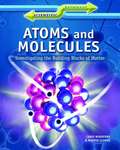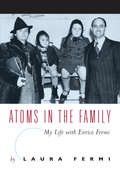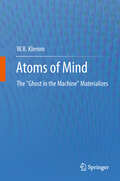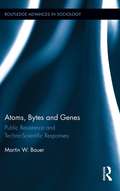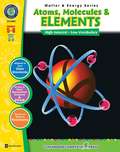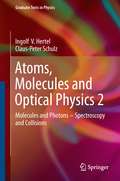- Table View
- List View
Atomic-Scale Electronics Beyond CMOS
by Mircea Dragoman Daniela DragomanThis book explores emerging topics in atomic- and nano-scale electronics after the era of Moore’s Law, covering both the physical principles behind, and technological implementations for many devices that are now expected to become key elements of the future of nanoelectronics beyond traditional complementary metal-oxide semiconductors (CMOS). Moore’s law is not a physical law itself, but rather a visionary prediction that has worked well for more than 50 years but is rapidly coming to its end as the gate length of CMOS transistors approaches the length-scale of only a few atoms. Thus, the key question here is: “What is the future for nanoelectronics beyond CMOS?” The possible answers are found in this book. Introducing novel quantum devices such as atomic–scale electronic devices, ballistic devices, memristors, superconducting devices, this book also presents the reader with the physical principles underlying new ways of computing, as well as their practical implementation. Topics such as quantum computing, neuromorphic computing are highlighted here as some of the most promising candidates for ushering in a new era of atomic-scale electronics beyond CMOS.
Atomic-Scale Insights into Emergent Photovoltaic Absorbers (Springer Theses)
by Alex GanoseThis book presents an original investigation into alternative photovoltaic absorbers. Solar power is a highly promising renewable energy solution; however, its success is hampered by the limited cost-effectiveness of current devices. The book assesses the photovoltaic performance of over 20 materials using state-of-the-art, first-principles methods. Adopting a computational approach, it investigates atomic-scale properties at a level of accuracy that is difficult to achieve using laboratory-based experimental techniques. Unlike many theoretical studies, it provides specific advice to those involved in experimental investigations. Further, it proposes directions for future research. This book advances the field of photovoltaics in three crucial ways: firstly, it identifies why one class of proposed materials cannot achieve high efficiency, while at the same time gaining insights that can be used to design future absorbers. Secondly, it shows that poor performance in the bismuth chalcohalides is not due to fundamental limitations, and can be overcome by finely controlling synthesis conditions. Lastly, it describes a range of new stable materials that are expected to show excellent photovoltaic performance.
Atomically Dispersed Metallic Materials for Electrochemical Energy Technologies (Electrochemical Energy Storage and Conversion)
by Jiujun Zhang Xueliang Sun Wei Yan Shuhui Sun Xifei LiAtomically dispersed metallic materials (ADMMs) are the most advanced materials used in energy conversion and storage devices to improve their performance for portable electronics, electric vehicles, and stationary power stations. Atomically Dispersed Metallic Materials for Electrochemical Energy Technologies aims to facilitate research and development of ADMMs for applications in electrochemical energy devices. It provides a comprehensive description of the science and technology of ADMMs, including material selection, synthesis, characterization, and their applications in fuel cells, batteries, supercapacitors, and H2O/CO2/N2 electrolysis to encourage progress in commercialization of these clean energy technologies. Offers a comprehensive introduction to various types of ADMMs, their fabrication and characterization, and how to improve their performance Analyzes, compares, and discusses advances in different ADMMs in the application of electrochemical energy devices, including commercial requirements Describes cutting-edge methodologies in composite ADMM design, selection, and fabrication Summarizes current achievements, challenges, and future research directions Written by authors with strong academic and industry expertise, this book will be attractive to researchers and industry professionals working in the fields of materials, chemical, mechanical, and electrical engineering, as well as nanotechnology and clean energy.
Atomically Precise Electrocatalysts for Electrochemical Energy Applications
by Anuj Kumar Ram K. GuptaThis book offers a comprehensive overview of atomically precise electrocatalysts, including single-atom, dual-atom, and multi-atom catalysts, which are considered to be superior electrode materials for fuel cells and water electrolyzers. By presenting a systematic examination of these materials in ascending order of metal atom number, the book provides a deep understanding of their synthesis processes, energy applications, and potential for improving their performance. Unlike any contemporary book on the topic, this book explores the reaction mechanisms and structure-performance relationships in catalytic processes at atomic level. Essentially, by driving the development of fuel cells and water electrocatalyzers, this book helps meet the world's growing energy demands. With its cutting-edge insights, this book is an indispensable resource for researchers, engineers, and students working in the field of renewable energy.
Atomically Precise Metal Clusters: Surface Engineering and Hierarchical Assembly
by Shuang-Quan ZangAtomically Precise Metal Clusters Thorough discussion on how surface modification and self-assembly play roles in the atomically precise formation and property tailoring of molecular clusters Atomically Precise Metal Clusters: Surface Engineering and Hierarchical Assembly summarizes and discusses the surface modification, assembly, and property tailoring of a wide variety of nanoclusters, including the well-explored metal clusters, addressing the structure–property relationships throughout. The atomic-level control in synthesis, new types of structures, and physical/chemical properties of nanoclusters are illustrated in various chapters. The controlled modification and assembly of metal nanoclusters is expected to have a major impact on future nanoscience research and other areas, with distinctive metal cluster-based function materials with precise structures uncovering exciting opportunities in both fundamental research and practical applications. Written by a highly qualified academic with significant research experience in the field, Atomically Precise Metal Clusters includes information on: Ligand engineering and assembly of coinage metal nanoclusters such as gold, silver, and copperRecent advances in post-modification of polyoxometalates and small transition metal chalcogenide superatom clustersSynthesis and assembly of cadmium chalcogenide supertetrahedral clusters and modification and assembly of Fe-S clustersIndium phosphide magic-sized clusters, ligand-tailoring platinum and palladium clusters, and metal oxo clusters (MOCs)Enabling access to desired functions in metal clusters for catalysis, optics, biomedicine, and other fields through surface engineering and supramolecular assembly A timely and comprehensive book that summarizes the recent progress in the surface modification and self-assembly of metal nanoclusters, Atomically Precise Metal Clusters provides essential guidance for graduate students and advanced researchers in material science, chemistry, biomedicine, and other disciplines.
Atomicity through Fractal Measure Theory: Mathematical and Physical Fundamentals with Applications
by Maricel Agop Alina Gavriluţ Ioan MercheşThis book presents an exhaustive study of atomicity from a mathematics perspective in the framework of multi-valued non-additive measure theory. Applications to quantum physics and, more generally, to the fractal theory of the motion, are highlighted. The study details the atomicity problem through key concepts, such as the atom/pseudoatom, atomic/nonatomic measures, and different types of non-additive set-valued multifunctions. Additionally, applications of these concepts are brought to light in the study of the dynamics of complex systems.The first chapter prepares the basics for the next chapters. In the last chapter, applications of atomicity in quantum physics are developed and new concepts, such as the fractal atom are introduced. The mathematical perspective is presented first and the discussion moves on to connect measure theory and quantum physics through quantum measure theory. New avenues of research, such as fractal/multifractal measure theory with potential applications in life sciences, are opened.
Atomistic Computer Simulations: A Practical Guide
by Veronika Brazdova David R. BowlerMany books explain the theory of atomistic computer simulations; this book teaches you how to run themThis introductory "how to" title enables readers to understand, plan, run, and analyze their own independent atomistic simulations, and decide which method to use and which questions to ask in their research project. It is written in a clear and precise language, focusing on a thorough understanding of the concepts behind the equations and how these are used in the simulations. As a result, readers will learn how to design the computational model and which parameters of the simulations are essential, as well as being able to assess whether the results are correct, find and correct errors, and extract the relevant information from the results. Finally, they will know which information needs to be included in their publications.This book includes checklists for planning projects, analyzing output files, and for troubleshooting, as well as pseudo keywords and case studies.The authors provide an accompanying blog for the book with worked examples, and additional material and references: http://www.atomisticsimulations.org/.
Atomistic Simulations of Glasses: Fundamentals and Applications
by Jincheng Du Alastair N. CormackA complete reference to computer simulations of inorganic glass materials In Atomistic Simulations of Glasses: Fundamentals and Applications, a team of distinguished researchers and active practitioners delivers a comprehensive review of the fundamentals and practical applications of atomistic simulations of inorganic glasses. The book offers concise discussions of classical, first principles, Monte Carlo, and other simulation methods, together with structural analysis techniques and property calculation methods for the models of glass generated from these atomistic simulations, before moving on to practical examples of the application of atomistic simulations in the research of several glass systems. The authors describe simulations of silica, silicate, aluminosilicate, borosilicate, phosphate, halide and oxyhalide glasses with up-to-date information and explore the challenges faced by researchers when dealing with these systems. Both classical and ab initio methods are examined and comparison with experimental structural and property data provided. Simulations of glass surfaces and surface-water reactions are also covered. Atomistic Simulations of Glasses includes multiple case studies and addresses a variety of applications of simulation, from elucidating the structure and properties of glasses for optical, electronic, architecture applications to high technology fields such as flat panel displays, nuclear waste disposal, and biomedicine. The book also includes: A thorough introduction to the fundamentals of atomistic simulations, including classical, ab initio, Reverse Monte Carlo simulation and topological constraint theory methods Important ingredients for simulations such as interatomic potential development, structural analysis methods, and property calculations are covered Comprehensive explorations of the applications of atomistic simulations in glass research, including the history of atomistic simulations of glasses Practical discussions of rare earth and transition metal-containing glasses, as well as halide and oxyhalide glasses In-depth examinations of glass surfaces and silicate glass-water interactions Perfect for glass, ceramic, and materials scientists and engineers, as well as physical, inorganic, and computational chemists, Atomistic Simulations of Glasses: Fundamentals and Applications is also an ideal resource for condensed matter and solid-state physicists, mechanical and civil engineers, and those working with bioactive glasses. Graduate students, postdocs, senior undergraduate students, and others who intend to enter the field of simulations of glasses would also find the book highly valuable.
Atomistic and Continuum Fracture Mechanics of Solids: An Integrated Treatment
by Shaker A. MeguidThis unique, first of its kind, book offers an integrated treatment of the atomistic-continuum behaviours of single and interacting microdefects under elasto-static loading. These microdefects may take the form of nanocracks, microcracks, microvoids, inclusions, and inhomogeneities. Professor Meguid elucidates the subject matter using novel treatment that offers a fresh look at molecular and continuum mechanics, imperfections in solids, the Griffith crack, modes of failure and diagnostics at varied length scales, LEFM and multiscale modeling of interacting microdefects. Providing a range of perspectives from theory and applications, this book is ideal for college seniors, graduate students, practicing and research engineers interested in failure analysis, diagnostics and prevention.
Atomistic and Continuum Modeling of Nanocrystalline Materials: Deformation Mechanisms and Scale Transition (Springer Series in Materials Science #112)
by Laurent CapolungoAtomistic and Continuum Modeling of Nanocrystalline Materials develops a complete and rigorous state-of-the-art analysis of the modeling of the mechanical behavior of nanocrystalline (NC) materials. Among other key topics, the material focuses on the novel techniques used to predict the behavior of nanocrystalline materials. Particular attention is given to recent theoretical and computational frameworks combining atomistic and continuum approaches. Also, the most relevant deformation mechanisms governing the response of nanocrystalline materials are addressed and discussed in correlation with available experimental data.
Atommüll - die teure Erbschaft: Von der Kernenergiegewinnung zur Endlagersuche (essentials)
by Klaus StierstadtBei der Energiegewinnung aus Atomkernen entstehen radioaktive Abfälle. Deren radioaktive Strahlung ist für belebte Materie außerordentlich schädlich. Solche Strahlenschäden werden besprochen und mit der natürlichen Strahlenbelastung verglichen. Der Atommüll muss sorgfältig entsorgt werden, was bis heute kaum geschieht. Die Möglichkeiten und Probleme einer sicheren Endlagerung werden diskutiert.
Atomphysik für Höhlenmenschen und andere Anfänger: Das Universum von innen: Moleküle, Atome und Elementarteilchen (essentials)
by Jürgen BeetzJürgen Beetz zeigt zuerst den Ursprung der erdachten Geschichten der Physik aus der Steinzeit, denn vieles ist so einfach, dass es schon Steinzeitmenschen hätten verstehen können. Im Anschluss daran erklärt der Autor den Aufbau von Atomen und sagt etwas zu ihren physikalischen Größen aus. Obwohl ,,Atom" eigentlich ,,unteilbar" bedeutet, bestehen Atome dennoch aus Teilen - dies erläutert er im Weiteren genau. Schließlich bespricht er die geheimnisvollen ,,Quanten" und ihr merkwürdiges Verhalten.
Atoms And Molecules Interacting With Light: Atomic Physics for the Laser Era
by Peter van der Straten Harold MetcalfThis in-depth textbook with a focus on atom-light interactions prepares students for research in a fast-growing and dynamic field. Intended to accompany the laser-induced revolution in atomic physics, it is a comprehensive text for the emerging era in atomic, molecular and optical science. <P><P>Utilising an intuitive and physical approach, the text describes two-level atom transitions, including appendices on Ramsey spectroscopy, adiabatic rapid passage and entanglement. With a unique focus on optical interactions, the authors present multi-level atomic transitions with dipole selection rules, and M1/E2 and multiphoton transitions. Conventional structure topics are discussed in some detail, beginning with the hydrogen atom and these are interspersed with material rarely found in textbooks such as intuitive descriptions of quantum defects. The final chapters examine modern applications and include many references to current research literature. The numerous exercises and multiple appendices throughout enable advanced undergraduate and graduate students to balance theory with experiment.
Atoms Under the Floorboards: The Surprising Science Hidden in Your Home
by Chris Woodford<p>Using the modern home as a springboard, Atoms Under the Floorboards presents the fascinating and surprising scientific explanations behind a variety of common (and often entertainingly mundane) household phenomena, from gurgling drains and squeaky floorboards to rubbery custard and shiny shoes. <p>Packed with facts and fun, each chapter focuses on the objects and processes familiar in everyday life and slowly unpicks the science behind them. For example, the chapter on how buildings work introduces static and dynamic forces in explaining why buildings (and their foundations) don't sink into the ground and why skyscrapers don't blow over in strong winds. The chapter on bicycles explores how "circles (better known as wheels) with a few flimsy bits of metal (spokes) stretched between them" are able to support your weight--and this leads into a discussion of compression, tension, and how gears work. <p>After reading Atoms Under the Floorboards, you'll never look at everyday objects the same way again.</p>
Atoms and Eden: Conversations on Religion and Science
by Steve PaulsonHere is an unprecedented collection of twenty freewheeling and revealing interviews with major players in the ongoing--and increasingly heated--debate about the relationship between religion and science. These lively conversations cover the most important and interesting topics imaginable: the Big Bang, the origins of life, the nature of consciousness, the foundations of religion, the meaning of God, and much more. In Atoms and Eden, Peabody Award-winning journalist Steve Paulson explores these topics with some of the most prominent public intellectuals of our time, including Richard Dawkins, Karen Armstrong, E. O. Wilson, Sam Harris, Elaine Pagels, Francis Collins, Daniel Dennett, Jane Goodall, Paul Davies, and Steven Weinberg. The interviewees include Christians, Buddhists, Jews, and Muslims, as well as agnostics, atheists, and other scholars who hold perspectives that are hard to categorize. Paulson's interviews sweep across a broad range of scientific disciplines--evolutionary biology, quantum physics, cosmology, and neuroscience--and also explore key issues in theology, religious history, and what William James called ''the varieties of religious experience. '' Collectively, these engaging dialogues cover the major issues that have often pitted science against religion--from the origins of the universe to debates about God, Darwin, the nature of reality, and the limits of human reason. These are complex, intellectually rich discussions, presented in an accessible and engaging manner. Most of these interviews were originally published as individual cover stories for Salon. com, where they generated a huge reader response. Public Radio's "To the Best of Our Knowledge" will present a major companion series on related topics this fall. A feast of ideas and competing perspectives, this volume will appeal to scientists, spiritual seekers, and the intellectually curious.
Atoms and Elements i Science
by McGraw-Hill Education StaffLearn more about elementary particles and other aspects of physics.
Atoms and Molecules: Investigating the Building Blocks of Matter (Scientific Pathways)
by Chris Woodford Martin Clowes<p>Greek philosophers first hypothesized that matter was composed of atoms, but the theory would not resurface again until the late 17th century. The idea that that atoms joined to form structures called molecules first appeared in the 19th century and helped explain why gases, liquids, and solids behave differently from one another. In the 20th century subatomic particles were discovered-electrons, protons, and neutrons-and atomic structure was finally understood. These breakthroughs led to the development of quantum theory and quantum mechanics. <p>This book details the inspiring and heroic discovery, delving deeply into intriguing stories, reviewing major scientific landmarks, and introducing readers to the vivid men and women who helped discover and map the microscopic universe that is the atom. Supplemental content includes an activity spread, a substantial and highly detailed timeline, and a list of key people with mini-biographies.</p>
Atoms in the Family: My Life with Enrico Fermi
by Laura FermiIn this absorbing account of life with the great atomic scientist Enrico Fermi, Laura Fermi tells the story of their emigration to the United States in the 1930s—part of the widespread movement of scientists from Europe to the New World that was so important to the development of the first atomic bomb. Combining intellectual biography and social history, Laura Fermi traces her husband's career from his childhood, when he taught himself physics, through his rise in the Italian university system concurrent with the rise of fascism, to his receipt of the Nobel Prize, which offered a perfect opportunity to flee the country without arousing official suspicion, and his odyssey to the United States.
Atoms in the Family: My Life with Enrico Fermi
by Laura FermiIn this absorbing account of life with the great atomic scientist Enrico Fermi, Laura Fermi tells the story of their emigration to the United States in the 1930s—part of the widespread movement of scientists from Europe to the New World that was so important to the development of the first atomic bomb. Combining intellectual biography and social history, Laura Fermi traces her husband's career from his childhood, when he taught himself physics, through his rise in the Italian university system concurrent with the rise of fascism, to his receipt of the Nobel Prize, which offered a perfect opportunity to flee the country without arousing official suspicion, and his odyssey to the United States.
Atoms of Mind: The "Ghost in the Machine" Materializes
by W. R. KlemmThis book describes the author's view of how the mind "thinks" at various levels of operation. These levels include nonconscious mind (as in spinal/brainstem reflexes and neuroendocrine controls), subconscious mind, and conscious mind. In the attempt to explain conscious mind, there is considerable critique of arguments over whether or not free will is an illusion. Finally, the author summarizes current leading theories for consciousness (Bayesian probability, chaos, and quantum mechanics) and then presents his own theory based on patterns of nerve impulses in circuits that are interlaced coherently into larger networks.
Atoms, Bytes and Genes: Public Resistance and Techno-Scientific Responses (Routledge Advances in Sociology #126)
by Martin W. Bauer"Atom," "byte" and "gene" are metonymies for techno-scientific developments of the 20th century: nuclear power, computing and genetic engineering. Resistance continues to challenge these developments in public opinion. This book traces historical debates over atoms, bytes and genes which raised controversy with consequences, and argues that public opinion is a factor of the development of modern techno-science. The level and scope of public controversy is an index of resistance, examined here with a "pain analogy" which shows that just as pain impacts movement, resistance impacts techno-scientific mobilization: it signals that something is wrong, and this requires attention, elaboration and a response to the challenge. This analysis shows how different fields of enquiry deal with the resistance of social-psychological mentalities in the face of industrial, scientific and political activities inspired by projected futures.
Atoms, Molecules and Elements
by George GraybillThis book provides ready-to-use information and activities for remedial students in grades five to eight. Written to grade and using simplified language and vocabulary, science concepts are presented in a way that makes them more accessible to students and easier to understand. Comprised of reading passages, student activities and overhead transparencies, our resource can be used effectively for whole-class, small group and independent work.
Atoms, Molecules and Optical Physics 1: Molecules and Photons - Spectroscopy and Collisions (Graduate Texts in Physics)
by Ingolf V. Hertel Claus-Peter SchulzThis is the first volume of textbooks on atomic, molecular and optical physics, aiming at a comprehensive presentation of this highly productive branch of modern physics as an indispensable basis for many areas in physics and chemistry as well as in state of the art bio- and material-sciences. It primarily addresses advanced students (including PhD students), but in a number of selected subject areas the reader is lead up to the frontiers of present research. Thus even the active scientist is addressed. This volume 1 provides the canonical knowledge in atomic physics together with basics of modern spectroscopy. Starting from the fundamentals of quantum physics, the reader is familiarized in well structured chapters step by step with the most important phenomena, models and measuring techniques. The emphasis is always on the experiment and its interpretation, while the necessary theory is introduced from this perspective in a compact and occasionally somewhat heuristic manner, easy to follow even for beginners.
Atoms, Molecules and Photons: An Introduction to Atomic-, Molecular- and Quantum Physics (Graduate Texts in Physics)
by Wolfgang DemtröderThis introduction to Atomic and Molecular Physics explains how our present model of atoms and molecules has been developed over the last two centuries both by many experimental discoveries and, from the theoretical side, by the introduction of quantum physics to the adequate description of micro-particles. It illustrates the wave model of particles by many examples and shows the limits of classical description. The interaction of electromagnetic radiation with atoms and molecules and its potential for spectroscopy is outlined in more detail and in particular lasers as modern spectroscopic tools are discussed more thoroughly. Many examples and problems with solutions are offered to encourage readers to actively engage in applying and adapting the fundamental physics presented in this textbook to specific situations.Completely revised third edition with new sections covering all actual developments, like photonics, ultrashort lasers, ultraprecise frequency combs, free electron lasers, cooling and trapping of atoms, quantum optics and quantum information.
Atoms, Molecules, And Light: Amo Science Enabling The Future
by Committee For An Updated Assessment Of Atomic Molecular Optical ScienceThe National Academies Press (NAP)--publisher for the National Academies--publishes more than 200 books a year offering the most authoritative views, definitive information, and groundbreaking recommendations on a wide range of topics in science, engineering, and health. Our books are unique in that they are authored by the nation's leading experts in every scientific field.
